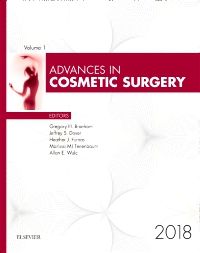Advances in Cosmetic Surgery, 2018, 1st Edition
Author Information
Shop by Category
| ISBN Number | 9780323639637 |
|---|---|
| Main Author | Edited by Gregory H. Branham, MD, Jeffrey S. Dover, MD, FRCPC, FRCP, Heather J. Furnas, MD, Marissa M.J. Tenenbaum, MD, Allan E. Wulc, MD, FACS and Alan Matarasso, MD,FACS |
| Copyright Year | 2018 |
| Edition Number | 1 |
| Format | Book |
| Trim | 178w x 254h (7.00" x 10.00") |
| Imprint | Elsevier |
| Page Count | 0 |
| Publication Date | 5 Jul 2018 |
| Stock Status | IN STOCK - This may take up to 5 business days to ship |
Editorial Board,
Contributors,
Introduction,
Preface: A Look at What’s New and What’s Coming in Cosmetic Surgery,
Nonsurgical Treatment of Submental Fullness
Video content accompanies this article at www. advancesincosmeticsurgery.com.
Introduction: nature of the problem and noninvasive approaches
Deoxycholic acid
Surgical technique
Potential complications/risks/benefits/ limits
Cryolipolysis
Preoperative planning
Preparation/procedural approach Immediate postprocedural care Rehabilitation and recovery
Clinical results in the literature Potential complications/risks/benefits/
limits
Ultrasound and radiofrequency devices
Summary/discussion
Nonsurgical Skin Tightening: Moving Below the Neck: Breast Lifting, Arm Lifting
Introduction
Energy-based devices for skin tightening
Radiofrequency
Ultrasound
Lasers
Shockwaves
New-Generation Fillers
Noninvasive skin tightening of the body
Neck
Decollete Area
Arms
Abdomen
Knees
Summary
Rejuvenation of the Neck
Introduction
Relevant anatomy The aged neck
Surgical technique
Preoperative planning
Surgical options
Positioning and surgical site preparation
Procedure approach
Rehabilitation and recovery
Potential complications/risks/benefits/limits
Management
Summary/discussion
Submentoplasty
Treatment of Striae: Are There Effective Treatments?
Video content accompanies this article at www. advancesincosmeticsurgery.com.
Introduction
Surgical technique
Preoperative planning
Preparation and patient positioning Immediate postprocedural care
Rehabilitation and recovery
Potential complications, risks, benefits, and limits
Management
Treatment of striae
Topical treatment of striae
Dermabrasion
Needling therapy
Light-based treatment of striae
Photodynamic therapy
Nonablative laser treatment of striae
Excimer
Pulse dye laser
Neodymium-doped yttrium aluminum garnet
Diode
Ablative laser treatment of striae
Fractional nonablative treatment of striae Fractional ablative treatment of striae
Erbium:yag laser
Co2 laser
Radiofrequency devices
Combination treatments
Summary
Updates in Cellulite Reduction
Video content accompanies this article at www. advancesincosmeticsurgery.com.
Introduction
Etiology
Treatment options to date Advances in treatment
Treatment technique for cellfina and
cellulaze
Preoperative planning (identical to both treatment options)
Cellfina
Cellulaze
Summary
Current Evidence in Nonsurgical Fat Reduction
Video content accompanies this article at www. advancesincosmeticsurgery.com.
Introduction: nature of the problem
Cryolipolysis (coolsculpting)
Preprocedure planning
Preparation and patient positioning
Procedural approach
Immediate post-procedural care Rehabilitation and recovery
Clinical results in the literature
Potential complications/risks/benefits/
limits
Management
Chemical lipolysis (deoxycholic acid/ kybella)
Preprocedure planning
Preparation and patient positioning
Procedural approach
Immediate post-procedural care Rehabilitation and recovery
Clinical results in the literature
Potential complications/risks/benefits/
limits
Management
Thermal modalities (ultrasound and radiofrequency)
Preprocedure planning
Ultrasound (ultraShape)
Radiofrequency (bodyFX) Rehabilitation and recovery
Potential complications/risks/benefits/
limits
Management
Summary/discussion
Nonsurgical Body Contouring
Introduction
Surgical technique
Preoperative planning
Preparation and patient positioning
Procedural approach
Immediate postprocedural care Rehabilitation and recovery
Clinical results in the literature
Lasers
Radiofrequency
Ultrasound
Cryolipolysis
Tissue stabilized–guided subcision
Potential complications, risks, benefits and limits
Management
Summary
Nonsurgical Vaginal Rejuvenation
Introduction
Pathophysiology
Clinical treatment indications
Traditional treatments modalities
Current alternative nonsurgical vaginal
rejuvenation options
Laser-tissue interactions: ablative lasers
Carbon dioxide laser
Erbium:yag laser
Radiofrequency
Beyond the vagina: additional applications
Urinary incontinence
Lichen sclerosus
Female genital aesthetics and intimacy
Summary
Cosmetic Surgery Following Weight Loss Surgery
Introduction: nature of the problem Surgical technique
Preoperative planning
Markings
Prep and patient positioning
Markings
Markings
Markings
Markings: abdominoplasty
Rehabilitation and recovery
Immediate postprocedural care
Clinical results in the literature
Potential complications/risks/benefits/limits
Management
Summary/discussion
Nonsurgical Facial Rejuvenation
By Neil SadickIntroduction
Topicals
Chemical peels and microdermabrasion
Ultrasound
Radiofrequency
Lasers
Lasers and Light Devices
Volumetric Fillers and Neurotoxins
Bringing It All Together with Combination Approaches
Summary
Radiofrequency with Microneedling
Introduction
Mechanisms of skin tightening and dermal rejuvenation
Cutaneous response to radiofrequency Cutaneous response to microneedling
Fractional radiofrequency: the evidence
Radiofrequency with microneedling: the
evidence
Patient selection
Radiofrequency with microneedling: the procedure
Summary
Injectable Fillers: Comparison of Materials, Indications, and Applications
Introduction
History of injectable fillers
Classification and mechanical properties of fillers
Types of biologic fillers
Hyaluronic acid
Bovine collagen
Human collagen
Types of synthetic fillers
Calcium hydroxylapatite
Poly-L-lactic acid
Polymethylmethacrylate
Product choice
Injection techniques and general considerations
Injection techniques
Blunt cannula versus fine needle
Patient Preparation
Rejuvenation of the upper face
Age-Related changes
Temples
Brows
Forehead
Glabella
Rejuvenation of the midface
Age-related changes
Malar region
Superior periorbital area
Inferior periorbital area
Crow’s feet
Nasolabial fold
Nose
Maxilla and alar base
Rejuvenation of the lower face
Age-related changes
Perioral region
Lips
Jawline
Jowls
Marionette lines
Other applications of injectable fillers
Hand
Acne and other scars
Gender-specific considerations in men
Complications and how to avoid them
Adverse effects
Immediate complications
Early complications
Late complications
Summary
High-Volume Lipofilling/Fat Transfer. New Methods, Techniques, and Technologies. What Is the Science?
Introduction
Surgical technique
Rehabilitation and recovery
Potential complications/risks/benefits/ limits
Discussion
Summary
Filler Complications
Introduction
Global filler safety
Complications
Nonischemic complications
Nodules/granulomas
Prolonged edema
Tyndall effect
Infection/biofilm
Ischemic complications
Soft tissue ischemia
Blindness/visual compromise
Summary
Current controversies/future considerations
Comprehensive Treatment of Scars and Other Abnormalities of Wound Healing
Video content accompanies this article at www. advancesincosmeticsurgery.com.
Introduction: the impact of scars
Clinical approach
Acne and other atrophic scars
Surgical technique: multimodal scar management
Preoperative planning/considerations
Preparation and patient positioning
Rehabilitation and recovery
Multimodal scar approach with algorithms
Potential complications/risks/limits/
benefits
Summary and future directions
Advances in the Treatment of Melasma: An Evidence-Based Approach
Introduction
Pretreatment planning
Patient history
Physical examination
Treatment approach
Topical therapy
Sun protection
Depigmenting agents
Oral therapy
Tranexamic acid
Chemical peels
Glycolic acid peels
Salicylic acid peels
Microneedling
Energy-based treatments
Nonablative lasers
1550-nm fractional laser
1927-nm fractionated nonablative thulium laser
Low-energy, low-density 1927-nm fractionated nonablative diode laser
Fully ablative lasers
Fractional ablative lasers
Intense pulsed light
Pulsed dye laser
Quality-switched lasers
Q-switched ruby
Q-switched neodymium:yttrium-aluminum- garnet laser
Picosecond lasers
Summary and discussion,
Picosecond Lasers: Do the Data Support the Claims?
Introduction
Basic principles of tattoo removal
Picosecond lasers and tattoos: the evidence
Challenges to the treating tattoos
Applying the evidence and treating the patient
Pretreatment planning
Treatment and posttreatment care
Innovations and future directions: the fractionation of picosecond pulses
Summary
Hair Biology and Androgenetic Alopecia: Diagnosis, Neogenesis, and Management
Introduction
Hair development
Hair cycling
Stem cell dysfunction in alopecia
Normal hair demographics
Diagnostic test for androgenetic alopecia
Androgenetic alopecia
Male pattern hair loss and treatment
Female pattern hair loss and treatment
Telogen effluvium and treatment
Novel approaches to androgenetic
alopecia
Platelet-rich plasma
Adipose tissue and stromal vascular fraction
Conditioned media
Low-level light therapy
Summary
Platelet-Rich Plasma: Fact or Fantasy?
Introduction
The history of platelet-rich plasma
Definition and functional components of platelet-rich plasma
Isolation of platelet-rich plasma and classification
Current platelet-rich plasma applications
Does platelet-rich plasma improve wound healing?
Does platelet-rich plasma improve scar appearance?
Does platelet-rich plasma enhance fat grafting?
Does platelet-rich plasma promote hair growth?
Does platelet-rich plasma rejuvenate the skin?
What is the role of platelet-rich plasma as an adjunct in cosmetic surgeries?
Platelet-rich plasma in other specialties
Adverse effects of platelet-rich plasma
Future direction of platelet-rich plasma: turning
fantasy into fact
Updates in Medical Skin Care
Introduction
Topical cosmeceutical goals
Key points
Skin-lightening cosmeceuticals
Key points
Peptide-containing cosmeceuticals
Key points
xii CONTENTS
Vitamin cosmeceuticals
Key points
Cosmeceutical botanicals
Key points
Summary
Patient Safety Issues: Venous Thromboembolism Prophylaxis by the Data
Introduction
Individualized risk stratification
Inpatient/outpatient surgery
Procedure-related risk
Preoperative optimization
Venous thromboembolism prevention strategies
Future avenues
Monitoring for adequacy of chemoprophylaxis
Is the 2005 caprini risk assessment model accurate for cosmetic surgery?
Summary
 Book
Book
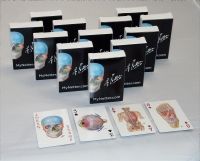 Flash Cards
Flash Cards
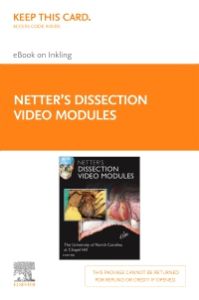 Online Resource
Online Resource
University of North Carolina Chapel Hill and Frank H. Netter
Oct 2015
 Book
Book
 Book
Book
Todd W. Vanderah
Jan 2019
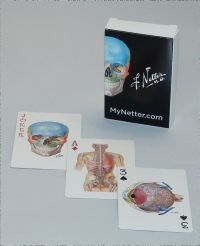 Flash Cards
Flash Cards
 Book
Book
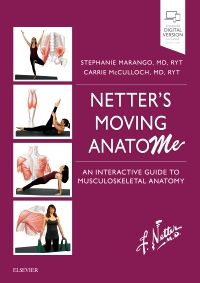 Book
Book
 Flash Cards
Flash Cards
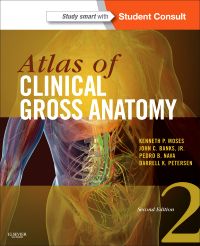 Book
Book
* Elsevier is a leading publisher of health science books and journals, helping to advance medicine by delivering superior education, reference information and decision support tools to doctors, nurses, health practitioners and students. With titles available across a variety of media, we are able to supply the information you need in the most convenient format.
Copyright © 2024, its licensors, and contributors.
All rights are reserved, including those for text and data mining, AI training, and similar technologies.
For problems or suggestions regarding this site, please visit our Support Hub.


